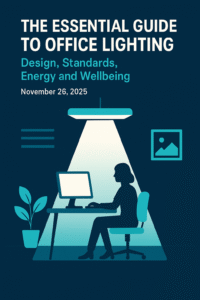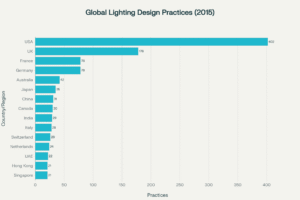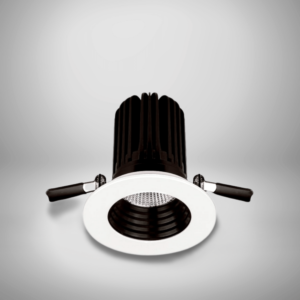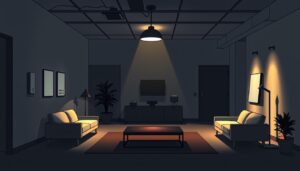As human beings, we spend up to 90% of our time indoors. On one hand, this is quite depressing, but on the other, it begs the question, how we can improve our buildings to nuture our health and wellbeing. As we explore WELL building standard v2, we’ll see how it’s changing our relationship to light in the built environment. We’ll learn more about how light has a significant impact on our mental health and natural circadian rhythms.
The WELL Building Standard, created by the International WELL Building Institute (IWBI), is a global benchmark for spaces that focus on human health. Its latest version, WELL takes a holistic view of building design and places a major emphasis on lighting as a crucial element for wellness.
In this article, we’ll see how WELL v2 is shaping the future of healthy buildings. We’ll look at its innovative methods for using light to support our circadian rhythms and mental health. From advanced lighting technologies to thoughtful design, we’ll investigate the transformative effect of light in our environments.
Key Takeaways
- WELL is a global standard for healthy buildings
- Light plays a crucial role in supporting circadian rhythms
- Proper lighting can significantly impact mental health
- WELL v2 emphasises the integration of natural and artificial light
- The standard promotes occupant well-being through innovative lighting strategies
Understanding the WELL Building Standard
The WELL Building Standard is transforming our view of the built environment. It focuses on creating spaces that boost health and wellbeing for those who use them. At its heart, it acknowledges the significant influence our surroundings have on our health and mental state.
What is the WELL Building Standard?
WELL is a system that evaluates, certifies, and tracks how buildings affect human health and wellbeing. It covers various aspects of building design, such as air, water, nourishment, light, fitness, comfort, and mind.
The importance of light in WELL v2
Light exposure is a key component in WELL v2. Studies have proven that high quality lighting can boost productivity, uplift mood, and help regulate sleep. WELL v2 stresses the importance of balanced light throughout the day, mimicking the body’s natural rhythms.
Key concepts and features
WELL v2 introduces several key concepts in visual lighting design:
- Circadian lighting design
- Glare control
- Electric light quality
These elements combine to create the best lighting conditions for occupant health and wellbeing. By incorporating these features, buildings can offer a more natural and comfortable setting for their users.
| Feature | Description | Benefits |
|---|---|---|
| L03: Circadian Lighting Design | Mimics natural light patterns | Improved sleep quality, increased alertness |
| L04: Glare Control | Reduces discomfort from bright light sources | Enhanced visual comfort, reduced eye strain |
| L07: Electric Light Quality | Ensures high-quality artificial lighting | Better colour rendering, reduced flicker |
The Science Behind Light and Human Health
Light is essential in our daily lives, affecting our circadian rhythms, mental health, and overall well-being. Now let’s look into how light exposure impacts our mind and body. Light shapes our mood, productivity, and sleep patterns.
Circadian Rhythms and Light Exposure
Our bodies rely on light cues to regulate our internal 24-hour clock, the circadian rhythms. Circadian photoentrainment happens when our bodies align with the natural light-dark cycle. This promotes optimal bodily functioning.
Effects of Light on Mood and Productivity
Proper light exposure greatly impacts our mental health and work performance. Bright light during the day boosts alertness and improves cognitive function. Its no conicidence that it also enhances our mood. In fact, studies reveal that office workers with natural light access report higher job satisfaction and productivity.
| Light Exposure | Effect on Mood | Effect on Productivity |
|---|---|---|
| Bright daylight | Improved mood | Increased focus |
| Dim lighting | Potential depression | Decreased efficiency |
| Blue-enriched light | Enhanced alertness | Better task performance |
Light's Impact on Sleep Patterns
The quality and timing of light exposure significantly affect our sleep patterns. Evening blue light from electronic devices can disrupt melatonin production, making it harder to fall asleep. On the other hand, natural morning light helps regulate our sleep-wake cycle. This promotes better sleep quality and duration.
“Light is the most potent agent to synchronise our internal body clock that regulates circadian rhythms, which in turn regulate our sleep patterns.” – Dr Sarah Lockley, Harvard Medical School
WELL Building Standard v2: A Comprehensive Approach to Lighting
WELL approaches visual lighting design with a holistic approach to illumination in buildings. It recognises the significant impact of light on human health and wellbeing. It also addresses various lighting aspects to create healthier and more comfortable environments.
The WELL v2 standard covers several critical areas of lighting design:
- Circadian lighting design
- Glare control
- Colour rendering
- Flicker management
- Integrating daylight and electric light
The WELL standard provides specific requirements and strategies for each lighting feature. It enables designers to create spaces that support occupants’ natural rhythms and visual comfort. The standard highlights the need for a balance between natural and artificial light sources for occupant well-being. In an ideal world, we would all rely exclusively on natural light but unfortunately this is not possible so electric lighting sources are therefore a necessity.
| Lighting Aspect | WELL v2 Approach | Benefits |
|---|---|---|
| Circadian lighting | Specific EML requirements | Improved sleep patterns and productivity |
| Glare control | Strict luminance limits | Enhanced visual comfort and reduced eye strain |
| Colour rendering | High CRI and TM-30-18 metrics | Accurate colour perception and improved aesthetics |
| Flicker management | Low-flicker light sources | Reduced headaches and visual discomfort |
WELL v2’s comprehensive lighting design ensures buildings meet functional needs while prioritising occupant health and wellbeing. By adopting these strategies, designers can craft spaces that truly support day to day life for human beings.
Circadian Lighting Design in WELL v2
WELL v2 introduces innovative approaches to enhance occupant wellbeing through lighting design. This section explores the concept of circadian lighting and its implementation within the WELL Building Standard.
Equivalent Melanopic Lux Requirements
The WELL building standard v2 utilises Equivalent Melanopic Lux (EML) as a key metric for circadian lighting. EML measures the impact of light on our circadian rhythm, considering the spectral sensitivity of melanopsin photoreceptors in our eyes. These requirements ensure that indoor lighting supports natural biological processes throughout the day.
| Time of Day | EML Requirement | Purpose |
|---|---|---|
| Morning | 240 EML or higher | Stimulate alertness |
| Midday | 180 EML or higher | Maintain energy levels |
| Evening | Less than 100 EML | Promote relaxation |
Implementing Circadian-Friendly Lighting
To achieve effective circadian photoentrainment, lighting systems must be carefully designed. This involves selecting appropriate light sources, controlling intensity and colour temperature, and of course, integrating with natural daylight. With the right commissioning, smart lighting controls can automatically adjust melanopic lux levels throughout the day, mimicking the natural progression of sunlight.
Benefits of Proper Circadian Lighting
Implementing circadian-friendly lighting in buildings can lead to numerous benefits for occupants. These include improved sleep quality, enhanced mood, increased productivity, and better overall health. By aligning indoor lighting with our natural circadian rhythms, we create environments that support our biological needs and promote optimal functioning.
“Proper circadian lighting design is not just about illumination; it’s about creating spaces that resonate with our innate biological rhythms, fostering health and well-being.” – Paul Simmons, Lumenloop
Glare Control and Visual Comfort
Proper glare control is essential for the most comfortable office lighting. WELL v2 highlights its importance by setting specific glare management and visual comfort standards. It’s not simply about light; it’s about creating a space that fosters wellbeing and productivity.
The WELL building standard standard introduces Feature L04, focusing on glare control. This feature aims to reduce discomfort and enhance visual comfort through various techniques. Let’s delve into the key aspects of glare control in office environments:
- Appropriate luminaire selection
- Glare rating calculations
- Implementation of shielding techniques
By tackling these elements, we can greatly improve visual comfort and lessen eye strain for office workers. This aligns with the aim of fostering healthier and more productive work environments.
To show the effect of glare control measures, let’s look at different lighting scenarios:
| Lighting Scenario | Glare Rating | Visual Comfort Level | Productivity Impact |
|---|---|---|---|
| No glare control | High | Low | Negative |
| Basic glare control | Moderate | Moderate | Neutral |
| WELL v2 compliant | Low | High | Positive |
As shown, proper glare control in line with WELL building standards can significantly enhance visual comfort and productivity. By focusing on these aspects in our lighting design, we craft spaces that genuinely support occupant wellbeing and performance.
Electric Light Quality and Colour Rendering
Electric light quality is something most people are not aware of in their daily lives. The WELL v2 standard highlights its importance, focusing on Colour Rendering Index (CRI) and TM-30-18 metrics. These standards ensure artificial lighting accurately shows colours, improving visual perception and potentially improving mood and productivity.
Although we highly recommend learning about the TM30 standard for colour rendering, its important to note that this has not replaced the way in which we measure CRI. Instead it has simply expanding on the way we measure it, by taking a deeper look at concepts such as fidelity and gamut.
Colour Rendering Index Requirements
CRI measures how well a light source reveals colours compared to natural light. WELL v2 sets specific CRI requirements for electric lighting:
- A minimum CRI of 90+ for optimal colour representation
- Alternatively, a CRI of 80+ with an R9 value (red spectrum) exceeding 50
TM-30-18 Metrics for Colour Fidelity
TM-30-18 is a more detailed method for evaluating light source colour rendition. It provides additional metrics beyond CRI, offering a nuanced understanding of how light affects colour perception.
Importance of Accurate Colour Representation
Accurate colour representation in lighting is vital for various reasons:
- Enhances visual comfort and reduces eye strain
- Improves task performance in colour-critical work environments
- Creates a more natural and pleasant atmosphere in indoor spaces
- Supports overall wellbeing by mimicking natural light conditions
By prioritising these aspects of electric light quality, WELL v2 aims to create healthier and more productive indoor environments. The standard’s focus on colour rendering ensures that occupants benefit from lighting that closely mimics natural light, supporting their visual comfort and overall wellness.
Managing Flicker for Occupant Wellbeing
Flicker is a critical element in visual lighting design, affecting occupant wellbeing. In WELL v2, managing flicker is a key focus to improve mental health and comfort in buildings. We understand the significance of reducing this often-neglected issue in lighting systems.
The WELL v2 standard mandates specific flicker reduction requirements. Lighting must operate at a minimum frequency of 90 Hz or show a low flicker risk below this. This goal is to prevent eye strain, headaches, and other health issues linked to subpar lighting.
To ensure optimal visual comfort, lighting designers should:
- Choose high-quality LED drivers and ballasts
- Install dimming systems that keep flicker levels low
- Opt for flicker-free light sources when feasible
By tackling flicker in lighting design, we can craft environments that raise occupant wellbeing and mental health in the long-term. This strategy aligns with WELL v2’s broader objectives of fostering healthier, more comfortable spaces for living and working.
Integrating Daylight and Electric Light
In modern building design, combining daylight and electric light is an essential strategy for healthy, productive spaces. According to this paper in ‘Energy and Buildings’, there are a host of other benefits, such as:
- Energy use can be reduced to a third of the existing benchmarks.
- Energy saving is achieved by using controls with proper monitoring and verification.
- Integrative lighting drives innovation
Balancing Natural and Artificial Light
Getting the balance right between daylight and electric light needs careful planning. We must consider building orientation, window placement, and interior layout. Placing workstations near windows maximises natural light, reducing artificial lighting needs.
Maximising Daylight Exposure
To optimise daylight, several strategies can be employed:
- Install light shelves to reflect sunlight deeper into the space
- Use clerestory windows to bring light into the building’s core
- Implement skylights or solar tubes for top-floor illumination
- Choose light-coloured interior finishes to enhance light reflection
Smart Lighting Controls
Smart lighting controls are crucial for seamless daylight and electric light integration. These systems use sensors to adjust artificial lighting based on ambient light levels. They can be programmed to maintain consistent illumination, supporting circadian rhythms and cutting energy use.
| Feature | Benefit |
|---|---|
| Daylight sensors | Automatically dim or switch off lights when sufficient natural light is available |
| Occupancy sensors | Ensure lights are only on when spaces are in use |
| Time-based controls | Adjust light colour temperature to mimic natural daylight patterns |
| Personal control apps | Allow occupants to customise lighting levels to their preferences |
By using these strategies and technologies, we can create spaces that blend natural and artificial light harmoniously. Not only does this promote occupant health and well-being but also optimises energy efficiency.
Occupant Control and Personalisation
The most comfortable office lighting doesn’t follow a replicable cookie-cutter format. Each environment needs to be analysed carefully since every building features unique variables that influences how light will interplay with its occupants. WELL v2 highlights the importance of occupant control and personalisation, often allowing individuals to adjust lighting to their preferences, catering to their unique needs and preferences. This increase in more granular control is becoming more popular in modern office lighting design with a real focus on customizable task lighting.
WELL v2 advocates for smart lighting systems that employees can customise. These systems enable adjustments to brightness and colour temperature. Such adaptability addresses various visual and circadian rhythm requirements, enhancing the comfort of the workspace.
Granting staff control over their lighting significantly improves their comfort and well-being. They can tailor the lighting to their specific tasks, whether it’s intense for concentrated work or softer for creative thinking. This personalisation transforms the office into a more welcoming environment, fostering happier and more productive teams.
In summary, WELL v2 acknowledges that the ideal lighting is that which adjusts to its users. By empowering occupants to control their environment, we pave the way for healthier and happier workspaces.
FAQ
What is the WELL Building Standard?
The WELL Building Standard is a global benchmark for healthy buildings and communities. It was established by the International WELL Building Institute (IWBI). It focuses on promoting health and wellness through various features, including lighting.
Why is light important in the WELL v2 standard?
Light is crucial for regulating human circadian rhythms, affecting mood, productivity, and sleep patterns. Proper light exposure enhances alertness and improves cognitive function. It also supports healthy sleep-wake cycles. WELL v2 highlights the need for lighting design that aligns with human biological needs.
What are the key lighting concepts and features in WELL v2?
WELL v2 addresses various lighting aspects, including circadian lighting design (L03), glare control (L04), electric light quality (L07), and flicker management. It provides specific requirements and optimisation strategies for each feature. This aims to create healthier and more comfortable environments.
How does WELL v2 address circadian lighting design?
Feature L03 in WELL v2 focuses on circadian lighting design, using Equivalent Melanopic Lux (EML) as a metric. It requires specific light levels at different times of day. This supports natural circadian rhythms, improving sleep quality, mood, and overall well-being.
How does WELL v2 approach glare control?
Feature L04 in WELL v2 addresses glare control, requiring specific measures to reduce discomfort and improve visual comfort. It includes using appropriate luminaires and calculating glare ratings. Proper shielding techniques are also implemented, contributing to improved visual comfort and reduced eye strain.
What are the requirements for electric light quality in WELL v2?
Feature L07 in WELL v2 focuses on electric light quality, including colour rendering. It specifies minimum CRI requirements (90+ or 80+ with R9 > 50) or alternative metrics using TM-30-18. High-quality colour rendering improves visual perception and can positively impact mood and productivity.
How does WELL v2 address flicker in lighting?
Feature L07, Part 2 in WELL v2 requires lighting to operate at a minimum frequency of 90 Hz or have a low risk of flicker (less than 5%) below 90 Hz. Reducing flicker helps prevent eye strain, headaches, and other negative health effects associated with poor-quality lighting.
How does WELL v2 promote the integration of daylight and electric light?
WELL v2 emphasises the importance of integrating daylight and electric light for optimal health benefits. It encourages strategies to maximise daylight exposure while providing appropriate electric lighting. Smart lighting controls and automation play a crucial role in maintaining proper light levels and supporting circadian rhythms throughout the day.
Does WELL v2 allow for occupant control and personalisation of lighting?
Yes, WELL v2 recognises the importance of occupant control and personalisation in lighting. Feature L08 addresses occupant lighting control, requiring tunable and automated lighting systems. These systems allow users to override settings and adjust light levels and colour temperature. This flexibility helps meet individual visual and circadian needs, enhancing comfort and well-being.












